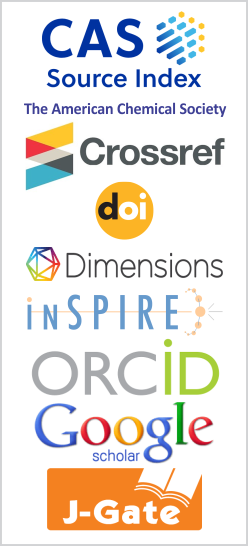Diamagnetic Susceptibility and Donor Binding Energy of Impurity States in Zinc Blende AlGaN/GaN Quantum Dot
DOI:
https://doi.org/10.26713/jamcnp.v6i3.1312Keywords:
Quantum dot, Binding energy, Nanoparticles, Variational methodAbstract
In the frame work of effective mass approximation, we have determined the donor binding energies of the most minimal donor states, \(1s\), \(2p_0\) and \(2p_{\pm}\), in zinc blende AlGaN/GaN Quantum dot in the impact of the magnetic field along the development(growth) directions. The calculations are performed utilizing variational method. The calculations are performed using variational method. As a function of the quantum dot radius and the applied magnetic field, the donor binding energies and diamagnetic susceptibilities are obtained. The oscillator quality of the potential transitions between the donor states is then figured by displaying them as the conditions of a two-level atom. Our outcomes demonstrate that (i) the donor binding energy is appreciable for smaller dot radii and magnetic field effect is predominant for larger dot radii, (ii) the diamagnetic susceptibility increases with applied magnetic field and is appreciable only for larger dot radii, (iii) The oscillator quality of the potential transitions between the donor states is not pronounced for smaller dot size radii and plays a significant role in larger dot radii.
Downloads
References
A. Corella-Madueno, R. A. Rosas, J. L. Marín and R. Riera, Phys. Low Dimens. Semicond. Struct. 5/6, 75 (1999), URL: https://www.researchgate.net/publication/286614613_Confinement_of_Hydrogenic_Impuritieswithin_Asymme_tric_and_Symmetric_Quantum_Wires .
Y. Wu and L. M. Falicov, Phys. Rev. B 29, 3671 (1984), DOI: 10.1103/PhysRevB.29.3671.
W. Hansen, T. P. Smith III, K. Y. Lee, J. A. Brum, C. M. Knoedler, J. M. Hong and D. P. Kern, Phys. Rev. Lett. 62, 2168 (1989), DOI: 10.1103/PhysRevLett.62.2168.
P. Ramvall, S. Tanaka, S. Nomura, P. Riblet and Y. Aoyagi, Appl. Phys. Lett. 73, 1104 (1998), DOI: 10.1063/1.122098.
A. Y. Cho and J. R. Arhur, Prog. Solid State Chem. 10, 157 (1975), DOI: 10.1016/0079-6786(75)90005-9.
P. D. Dapkus, Annu. Rev. Mater. Sci. 12, 243 (1982), DOI: 10.1146/annurev.ms.12.080182.001331.
G. Cantele, D. Nino and G. Iadonisi, J. Phys. Condens. Matter 12, 9019 (2000), DOI: 10.1088/0953-8984/12/42/308.
Y. Wang and N. Herron, J. Phys. Chem. 95, 525 (1991), DOI: 10.1021/j100155a009.
A. D. Yoffe, Adv. Phys. 51, 1 (2001), DOI: 10.1080/00018730010006608.
G. Bastard, Phys. Rev. B 24, 4714 (1981), DOI: 10.1103/PhysRevB.24.4714.
N. Porras-Montenegro and S. T. Perez-Merchancano, Phys. Rev. B 46, 15 (1992), DOI: 10.1103/PhysRevB.46.9780, and references therein.
C. Maihiot, Y. Chang and T. C. McGill, Phys. Rev. B 26, 4449 (1982), DOI: 10.1103/Phys-RevB.26.4449.
S. Nakamura and S. F. Chichibu, Introduction to Nitride Semiconductor Blue Lasers and LEDs, Taylor & Francis, London (2000), DOI: 10.1201/9781482268065.
S. Krishnamurthy, K. Nashold and A. Sher, Appl. Phys. Lett. 77 (2000), 355, DOI: 10.1063/1.126974.
S. F. Chichibu, M. Sugiyama, T. Onuma, T. Kitamura, H. Nakanishi, T. Kuroda, A. Tackeuchi, T. Sota, Y. Ishida, H. Okumura, Appl. Phys. Lett. 79, 4319 (2001), DOI: 10.1063/1.1428404.
Y. Yang, X. A. Cao and C. H. Yan, Appl. Phys. Lett. 94, 041117 (2009), DOI: 10.1063/1.3077017.
E. P. Pokatilov and D. L. Nika, Appl. Phys. Lett. 89, 113508 (2006), DOI: 10.1063/1.2349835.
L. M. Jiang, H. L. Wang, H.T. Wu, Q. Gong and S. L. Feng, J. Appl. Phys. 105, 053710 (2009), DOI: 10.1063/1.3080175.
F. C. Jiang and C. X. Xia, Physica B, 403, 165 (2008), DOI: 10.1016/j.physb.2007.08.153.
C. X. Xia, S. Y. Wei and X. Zhao, Appl. Surf. Sci. 253, 5345 (2007), DOI: 10.1016/j.apsusc.2006.12.008.
H. Wang, L. Jiang, Q. Gong and S. Feng, Physica B 405, 3818 (2010), DOI: 10.1016/j.physb.2010.06.008.
C. X. Xia, Y. M. Liu and S. Y. Wei, Phys. Lett. A 372, 6420 (2008), DOI: 10.1016/j.physleta.2008.08.062.
A. F. Wright and J. S. Nelson, Appl. Phys. Lett. 66 (1995), 3051, DOI: 10.1063/1.114274. [24] H. Wang, G. A. Farias and V. N. Freire, Phys. Rev. B 60 (1999), 5705, DOI: 10.1103/Phys-RevB.60.5705, and reference therein.
J. J. Sharkey, C. K. Yoo and A. J. Peter, Superlatt. Microstruct. 48 (2010), 248 – 255, DOI: 10.1016/j.spmi.2010.04.016.
Downloads
Published
How to Cite
Issue
Section
License
Authors who publish with this journal agree to the following terms:- Authors retain copyright and grant the journal right of first publication with the work simultaneously licensed under a CCAL that allows others to share the work with an acknowledgement of the work's authorship and initial publication in this journal.
- Authors are able to enter into separate, additional contractual arrangements for the non-exclusive distribution of the journal's published version of the work (e.g., post it to an institutional repository or publish it in a book), with an acknowledgement of its initial publication in this journal.
- Authors are permitted and encouraged to post their work online (e.g., in institutional repositories or on their website) prior to and during the submission process, as it can lead to productive exchanges, as well as earlier and greater citation of published work.




